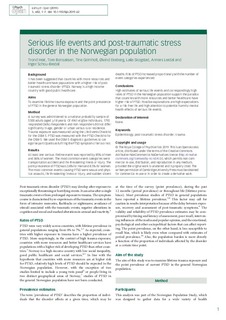Serious life events and post-traumatic stress disorder in the Norwegian population
Heir, Trond; Bonsaksen, Tore; Grimholt, Tine Kristin; Ekeberg, Øivind; Skogstad, Laila; Lerdal, Anners; Bredal, Inger Schou
Journal article, Peer reviewed
Published version
Permanent lenke
http://hdl.handle.net/11250/2633858Utgivelsesdato
2019Metadata
Vis full innførselSamlinger
- Artikler / Articles [1184]
- Publikasjoner fra CRIStin [1110]
Sammendrag
Background: It has been suggested that countries with more resources and better healthcare have populations with a higher risk of posttraumatic stress disorder (PTSD). Norway is a high-income country with good public healthcare.
Aims: To examine lifetime trauma exposure and the point prevalence of PTSD in the general Norwegian population.
Method: A survey was administered to a national probability sample of 5500 adults (aged ≥18 years). Of 4961 eligible individuals, 1792 responded (36%). Responders and non-responders did not differ significantly in age, gender or urban versus rural residence. Trauma exposure was measured using the Life Events Checklist for the DSM-5. PTSD was measured with the PTSD Checklist for the DSM-5. We used the DSM-5 diagnostic guidelines to categorise participants as fulfilling the PTSD symptom criteria or not.
Results: At least one serious lifetime event was reported by 85% of men and 86% of women. The most common event categories were transportation accident and life-threatening illness or injury. The point prevalence of PTSD was 3.8% for men and 8.5% for women. The most common events causing PTSD were sexual and physical assaults, life-threatening illness or injury, and sudden violent deaths. Risk of PTSD increased proportionally with the number of event categories experienced.
Conclusions: High estimates of serious life events and correspondingly high rates of PTSD in the Norwegian population support the paradox that countries with more resources and better healthcare have higher risk of PTSD. Possible explanations are high expectations for a risk-free life and high attention to potential harmful mental health effects of serious life events.
